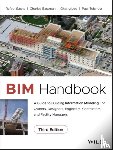Stel een vraag
Ik heb een vraag over het boek:
‘BIM Handbook - Sacks, Rafael (Israel Institute of Technology), Eastman, Charles (Georgia Institute of Technology, Lee, Ghang (Yonsei University in Seoul, Teicholz, Paul (Stanford University)’.
Vul het onderstaande formulier in.
We zullen zo spoedig mogelijk antwoorden.


